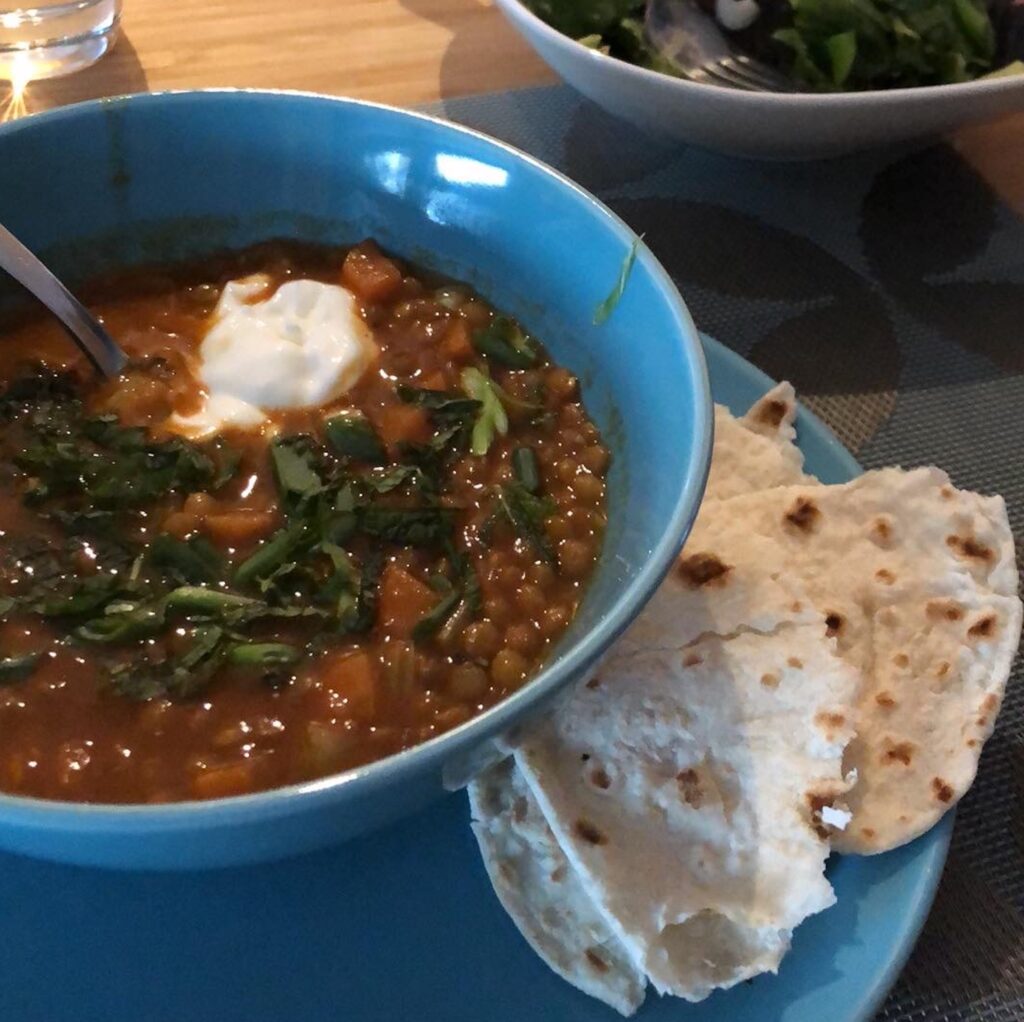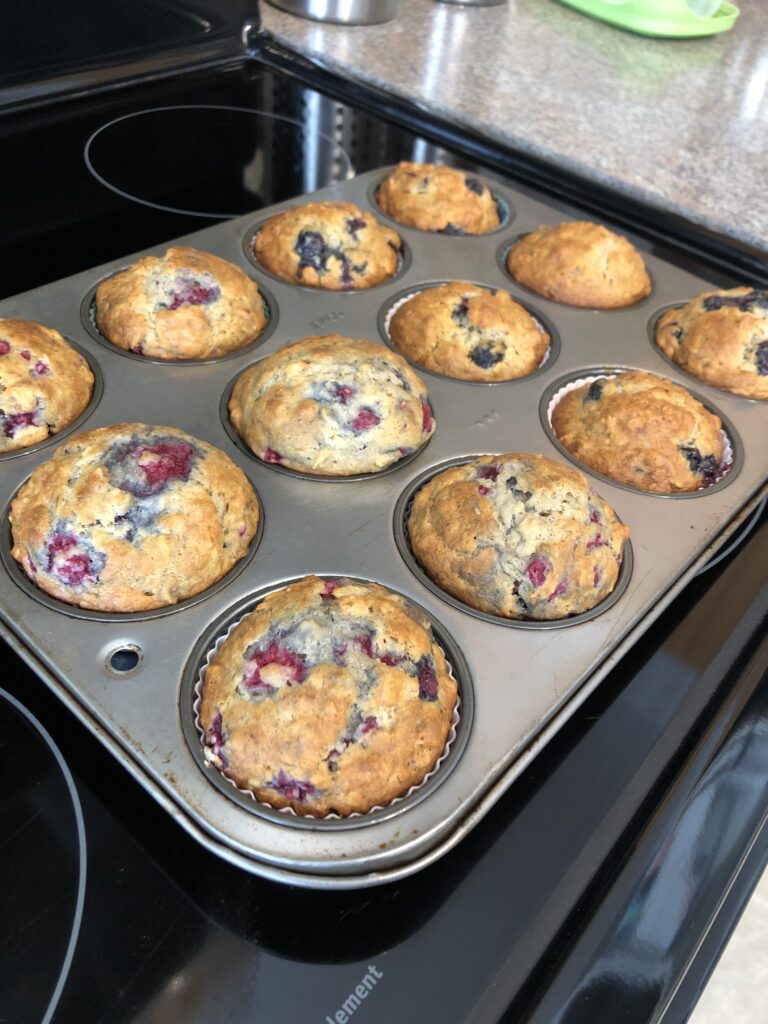We’ve all stood in our kitchen at some point, with the fridge door wide open, wondering what we could possibly make to satisfy our hunger or craving. Am I right?! Having access to key ingredients (i.e. grocery staples) is essential in these moments so we can whip up some simple and nutritious meals or snacks in no time. So many reasons make plain yogourt a favourite grocery staple of mine.
Why is Yogourt a Must-Have Grocery Staple?
Yogourt is not only nutritious, but it’s also super creamy and delicious. It can add texture and essential nutrients to our day to help keep us energized and satisfied, at least for a couple of hours. I used to eat it mainly as a snack until I realized its potential in the kitchen. Let me share a bit of a back story.
It all started with some nachos and a tub of spoiled sour cream! Weird start, I know! Let me explain. One of my favourite meals on a Friday night is nachos, with lots of veggies, cheese, toppings (cilantro, avocado, etc.) and most importantly… sour cream for dipping. Of course, as I wait for the nachos to cook in the oven, I reach for the tub of sour cream hanging out at the back of the fridge for quite some time. My friends and family know I’m all for eating certain food items past their “best before” date so long as they pass the “sniff” test. That said, when there are visible pink spots… that’s a no-go, even for me.
Needless to say, I was left with a pan of hot cheesy deliciousness that night and nothing to dip it in – how disappointing. Well, the gourmet chef in me wasn’t about to settle for that. That’s when yogourt came to my rescue and became one of my favourite grocery staples in my kitchen.
Plain Yogourt as a Sour Cream Substitution.
Since finding out about this substitution, I basically stopped buying sour cream. You may think I’m a little crazy, but yogourt does taste very similar to sour cream. If you look further into how yogourt and sour cream are made, you’ll realize that they are both fermented dairy products: yogourt made from milk and sour cream from cream (i.e. the part of milk that is higher in fat). So the creamier or higher fat the yogourt, the closer you are getting to sour cream.
Although yogourt and sour cream are very similar, I somehow can’t see myself eating a bowl of sour cream with fruit. In addition to that, yogourt is typically sold in larger formats, making it more budget-friendly and convenient when it comes to the amount I need on a weekly or bi-monthly basis.
How Can You Use Plain Yogourt?
Here are my 5 favourite ways to use plain yogourt in recipes, including some practical examples you can try for yourself at home. I promise it won’t disappoint!
1. Toppings
Picture some hot steamy baked potato with a dollop of plain yogourt, freshly cracked salt & pepper and a sprinkle of chive… are you drooling yet? I also use it as a topping for my nachos, tacos, burritos—you name it. As mentioned above, plain yogourt makes for an awesome sour cream substitute. If you’re looking for a way to spice up your waffles or crepes, and maybe even a little protein to your breakfast, try topping it with some plain yogourt, fruit (fresh or frozen) and a drizzle of maple syrup. Yum!

2. Smoothies
If you’ve got some frozen fruit in the back of your freezer, or even some not-so-fresh fruit lying around in the fridge, throw it into a blender with some plain yogourt, your liquid of choice (water, milk, plant-based beverage, juice, etc.) and any other add-ons of your choice. With this combination, you’ve got yourself a quick on-the-go breakfast or snack.
Try spicing up your smoothie with some seeds, oats, spinach or whatnot. I find yogourt adds a creamy texture to my smoothies and helps bind the fruit and liquid together nicely.

3. Fruit Parfaits
This one is pretty straightforward, yet there are many ways to go about it. Try topping the yogourt with fruits, seeds, crunchy granola and some sweetener of your choice. You can also mix some peanut butter into your yogourt for an extra boost of flavour, protein and healthy fats. I bet it’s pretty yummy with some banana slices and chocolate granola.

4. Dips, Salad Dressings & Sauces
Dips are my absolute favourite, especially as a last-minute potluck dish. Make your homemade yogourt-based dip (spinach dip, ranch, chocolate/peanut butter, you name it!) to serve with a loaf of bread, a fruit or vegetable platter. With this combination, you’ve probably got yourself the freshest and most delicious snack at the party. It beats a pack of store-bought grocery store cookies if you ask me!
I also love mixing yogourt with lime juice and sriracha as a sauce for my fresh spring rolls or sushi. You could also mix yogourt with some store-bought ranch dressing to make the most out of what’s left in the bottle.

5. Baked Goods
I often use yogourt for baked goods such as muffins or banana bread. Some recipes already call for it, but it can also be used as a substitute for oil or butter in most cases.
Don’t get me wrong, there is nothing wrong with using oils or butter in your recipes. Oils are a very healthy source of unsaturated fats, which we need in our diet. However, if you’re looking for an alternative, whether you have run out of the original ingredient or don’t want to pay the big bucks for butter, you have yet another option. Depending on the type of yogourt you are using, it can even boost the protein content of your recipe, leaving you well-nourished and satisfied. I call that a win-win!

Yogourt FAQs (Frequently Asked Questions)
What Are The Nutritional Benefits of Yogourt?
Yogourt is a dairy product and fits into the “Protein” or “Meat and Alternatives” food group. In addition to its high protein content, it is also a great source of vitamin D and calcium. These nutrients support strong bones and muscles. Some brands of yogourt also contain probiotics, which are healthy bacteria that help with digestion. Yogourts can also be sold as plain or flavoured. Although flavoured yogourts can be delicious, they do contain added sugars. My preference is plain yogourt given its versatility – use it as is in savoury recipes and add your sweetener of choice, in the quantity that feels right to you, in sweeter recipes.
What Yogourt Brand is Best?
Honestly, my initial response to this question is “it depends”. There are so many factors to consider beyond the nutritional value. However, I have to admit, there are so many yogourt brands out there. It can get very overwhelming. My practical tip is to first look at the yogourts on sale and narrow down your search from there.
Ultimately, there are 3 main types of plain yogourt: your good old regular yogourt, Greek yogourt and Skyr or Icelandic yogourt. The primary difference lies in the amount of protein they each contain. Regular yogourt has the lowest amount of protein (10-12g per cup) where Icelandic yogourt has the most (25-28g protein per cup). Greek yogourt is not too far behind with approximately 21-25g of protein per cup.
The important thing to note is that protein content will make a difference in the yogourt’s texture. In the end, it comes down to your personal preference. Regardless of if you choose the thicker (higher protein content) or thinner yogourt (lower protein content), you should be able to use it in any of the suggestions mentioned above.
Personally, I enjoy the higher protein content of Greek or Icelandic yogourt. In instances where the texture is too thick, for example for sauces and salad dressings, you can always water it down to your desired consistency.
Does the Fat Percentage of Yogourt Matter?
There is a wide range of %M.F (which stands for the percentage of milk fat) in dairy products—particularly for yogourt. You will typically find yogourts containing anywhere from 0% to 5% M.F., but I’ve seen some up to 11%. Higher-fat yogourts are often labelled as “extra-creamy” which can be delicious, particularly in dessert recipes. Most yogourt brands will have a few M.F. options, which is why this is usually the last thing I check on the label.
From a health perspective, the fat in yogourt is considered to be saturated, which current healthy eating guidelines suggest we limit—particularly for the prevention and management of high cholesterol or heart disease. Now, that doesn’t mean you have to choose 0% yogourt either. It’s perfectly fine to choose yogourt with 1% or 2% M.F. and it will also likely keep you fuller for longer as compared to 0% M.F. alternatives. So again, it comes down to preference and your personal health goals. However, if you are looking for versatility in your recipes, look for 1-2% M.F. options.
Bottom Line.
Yogourt is a great grocery staple and an impeccable sour cream substitute. Above all, yogourt can be used in many recipes to boost its protein content, improve texture or simply out of convenience. When it comes to choosing the type or brand, it will depend on your personal preferences, budget and health goals. If you don’t already have a go-to option, my recommendation is to first identify the yogourt brands that are on sale that week. From there, determine which type of yogourt you want (i.e. regular vs Greek vs Icelandic) and then pick the %M.F. that fits your needs.
